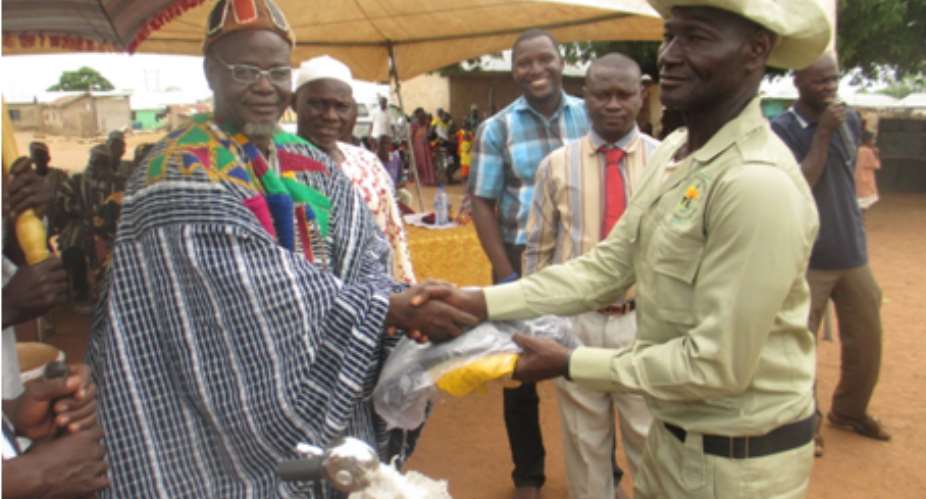The Wasipewura Mimuni Anyami Kabasagya II, chief of the Wasipe Traditional Council has inaugurated five (5) CREMA Monitoring Units in communities under the CREMA Program at Daboya, the North Gonja District Capital. This was part of efforts to empower communities to undertake local off-reserve biodiversity monitoring and support the Community Resource Management Committees (CRMCs) to improve sustainable natural resource management practices in communities as well as regulate access and utilization for accelerated fauna recruitment and flora regeneration in the CREMA areas.
In his Speech, he tasked the CREMA Monitoring Units to establish monitoring protocol to allow for ascertaining changes in the environment and also work to secure the management areas against external aggression while regulating internal threats.
In a speech read on his behalf by the Secretary of the Wasipe Traditional Council, Mr. Haruna Muaz stated that the recent surging threat of illegal logging of rosewood in the country which included some communities within the Wasipe jurisdiction had seen massive depletion of the natural resources. The menace of illegal rosewood logging and lumbering activities has had a devastating effect on the livelihoods of the local indigenes as most of the youth’s lost their interest in farming.
Tractors were not available to farmers to help them plough amongst many others, trees have been felled indiscriminately and our already fragile landscapes have been left exposed. He thus acknowledged that the initiative if effectively managed and empowered will serve as the starting point in dealing with this canker. Since it is communally owned, communities can easily mobilize to ensure their resources are not abused.
The Assistant District Coordinating Director, Mr. Bawa Nuhu Lesseini, commended A Rocha Ghana and its partners for providing technical and financial support to the communities and the Assembly. He also pledged the Assembly’s support in putting in place the necessary legal and institutional framework such as bye-laws to enable the CREAMAs and the Monitoring Unit function effectively. He asked the Unit to support the communities to safeguard their natural resources and urged the Traditional authorities to use their traditional mandate to influence better decision that affect livelihoods and the environment positively.
In a solidarity speech, the Northern Sector Manager of A Rocha Ghana, Mr. Daryl Bosu reiterated A Rocha Ghana’s commitment and support for ensuring the establishment, capacity building and support for community based natural resource governance and sustainable utilization of natural resources now and in the future.
He also indicated that A Rocha Ghana was committed to partner with The District Assembly, Traditional Authorities, the Wildlife Division and all relevant stakeholders to promote effective management of resource within the fragile savanna eco-zone of Ghana. He thanked Ecosystem Alliance (Wetlands, IUCN, and BothEnds) and FFEM for funding and supporting the establishment and development of Community Resource Management Areas (CREMAs) in Ghana.
The distinguishing goal of the CREMA strategy is to empower the local people by according them the necessary power and control to take center stage in natural resources management by utilizing their own capacity to assure their livelihood security and environmental conservation. This position is premised on the recognition by many experts that conservation areas and values in many countries will survive better if human concerns of subsistence, survival, livelihood, income generation, social recognition are addressed. The CREMAs around Mole National Park have a great potential to realize real benefits if management practices agreed on are applied.
The Monitoring Units were provided with equipment such Uniforms, Bicycles, Raincoats and Wellington boosts to aid in community patrols and local monitoring of environmental changes.
 2015-06-11 160833
2015-06-11 160833
 2015-06-11 160915
2015-06-11 160915
 2015-06-11 160955
2015-06-11 160955





 Tuesday’s downpour destroys ceiling of Circuit Court '8' in Accra
Tuesday’s downpour destroys ceiling of Circuit Court '8' in Accra
 SOEs shouldn't compromise on ethical standards, accountability – Akufo-Addo
SOEs shouldn't compromise on ethical standards, accountability – Akufo-Addo
 Father of 2-year-old boy attacked by dog appeals for financial support
Father of 2-year-old boy attacked by dog appeals for financial support
 Jubilee House National Security Operative allegedly swindles businessman over sa...
Jubilee House National Security Operative allegedly swindles businessman over sa...
 Nobody can order dumsor timetable except Energy Minister – Osafo-Maafo
Nobody can order dumsor timetable except Energy Minister – Osafo-Maafo
 Mahama wishes National Chief Imam as he clock 105 years today
Mahama wishes National Chief Imam as he clock 105 years today
 J.B.Danquah Adu’s murder trial: Case adjourned to April 29
J.B.Danquah Adu’s murder trial: Case adjourned to April 29
 High Court issues arrest warrant for former MASLOC Boss
High Court issues arrest warrant for former MASLOC Boss
 Align academic curriculum with industry needs — Stanbic Bank Ghana CEO advocates
Align academic curriculum with industry needs — Stanbic Bank Ghana CEO advocates
 Election 2024: We'll declare the results and let Ghanaians know we've won - Manh...
Election 2024: We'll declare the results and let Ghanaians know we've won - Manh...
